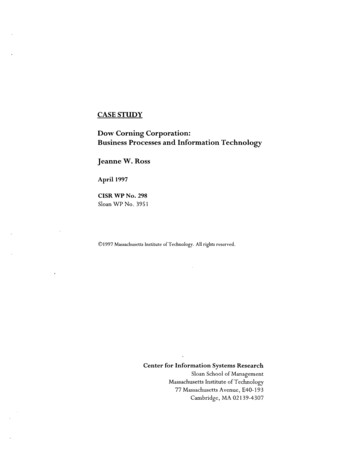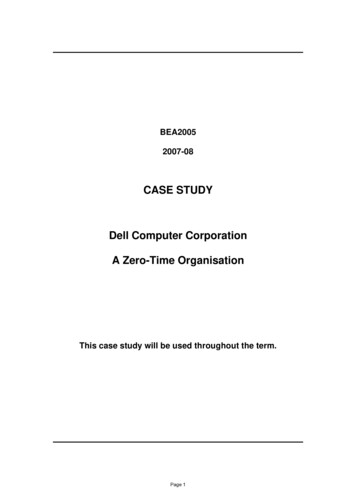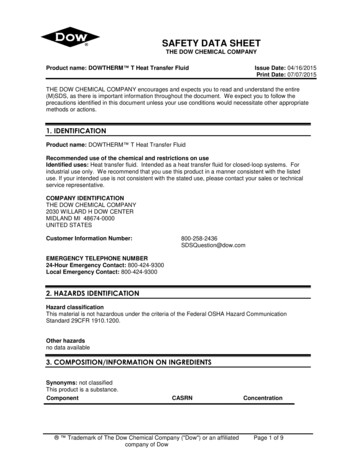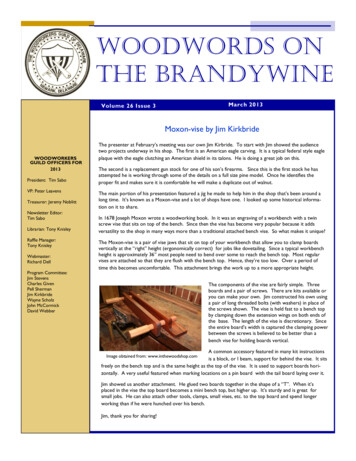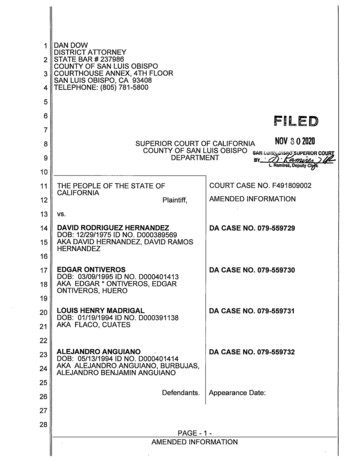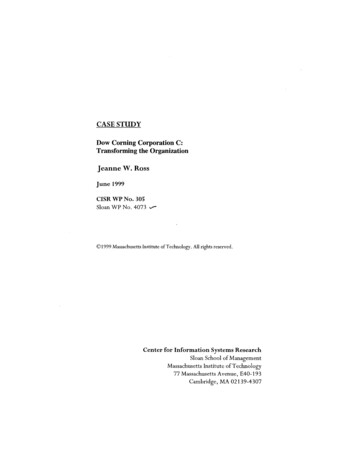
Transcription
CASE STUDYDow Corning Corporation C:Transforming the OrganizationJeanne W. RossJune 1999CISR WP No. 305Sloan WP No. 4073 v"( 1999 Massachusetts Institute of Technology. All rights reserved.Center for Information Systems ResearchSloan School of ManagementMassachusetts Institute of Technology77 Massachusetts Avenue, E40-193Cambridge, MA 02139-4307
CISR Working Paper No. 305Title:CASE STUDY-Dow Corning Corporation C:Transforming the OrganizationAuthor:Jeanne W. RossDate:June 1999Abstract: Dow CorningCorporation(C):Transformingthe Organizationis the third in a seriesof cases that describes Dow Corning management's decision to implement SAP as the first step ina long-term reengineering process and its subsequent implementation efforts. Part A describes therole of IT at Dow Corning in the early 1990s and management's decision to view IT as a strategicasset, which led to decisions to name a CIO and implement SAP. The second part of the casedescribes the firm's approach to ERP implementation ending with a discussion of the pilotimplementation in three European sites. This third case is intended as a follow-on to complete thediscussion of the implementation. The case describes how the firm captured its learnings from thepilot implementation and successfully implemented SAP on a global basis. The case thenexamines the outcomes from the implementation. It is clear that despite its success in getting thesystem in, Dow Corning has much work yet to do in order to ensure that the firm derives real,long-term benefits from the system. It is intended to both describe the persistence and focus thatled to a successful large-scale ERP implementation as well as reveal the ongoing challenges ofmanaging in an ERP environment.19 pagesThis paper is also available from the Sloan Working Paper Series as Sloan Working PaperNo.4073.
UCenter for Information Systems ResearchSloan School of ManagementMassachusetts Institute of TechnologyDow Corning Corporation C: Transforming the OrganizationIn February, 1999, Charlie Lacefield, Vice President and Executive Director of BusinessProcesses and Information Technology (BPIT) at Dow Coming, reflected on the firm's recentcompletion of a massive SAP implementation effort within budget and on schedule. Nonetheless,he observed that the systems implementation was merely the first stage in the firm's large-scalereengineering effort:The SAP implementation has resulted in three major changes in Dow Coming.One, we have taken a significant step toward being a fully integrated globalcompany. Two, we have become process-oriented; people realize theirinterdependence. Three, we have increased our discipline in how we perform ourprocesses. Now we have to accelerate productivity improvement and growrevenue without significantly increasing our employment levels. And we have toattack commercialization-getting product that meets customer needs to marketfaster and sharing the knowledge to do that better on a global basis, as well asunderstanding the customers' service needs as part of the total value of DowCorning's offerings.After thirty-six years at Dow Corning, Lacefield was preparing to retire. He felt he was leaving acompany that was in the process of transforming itself.BackgroundDow Corning Corporation, a jointly owned enterprise of the Dow Chemical Company andCorning, Inc., developed and manufactured silicone materials and polycrystalline silicon. In 1998the company had sales of 2.5 billion and approximately 9000 employees on five continents.Although based in Midland, Michigan, USA, over half of Dow Corning's sales were generatedoutside the US, and for two years the company had seen its sales languishing due to a severefinancial crisis in Asia. The Asian crisis had arrived on the heels of financial pressures resultingfrom protracted litigation around breast implants, which had resulted in a filing for Chapter 11bankruptcy protection in 1995.1 (Financial results through 1997 are shown in Exhibit C1.)Responding to competitive pressures that demanded both cost effectiveness and customerresponsiveness, Dow Corning had decided in early 1995 to embark on Project Pride, a corporatewide reengineering effort that used SAP to provide the applications infrastructure for greaterintegration across the firm's product lines and geographies. In its early discussions about ProjectIn 1999, Dow Corning and the official Committee representing Tort Claimants agreed to a joint plan toresolve product liability claims in the bankruptcy. A confirmation hearing was scheduled for Summer 1999for the bankruptcy judge to consider confirming the plan and ending the bankruptcy.This case was preparedby Jeanne Ross at the MIT Centerfor Information Systems Research. The authorwould like to thank Chuck Gibson and Michael Vitale for their helpful comments, and Charlie Lacefield,Dick Hazleton, and many other Dow Coming employees who so generously contributed insights,cooperation, and support.
Pride, Dow Corning's senior management team acknowledged that anticipated financial returnsfrom Project Pride would materialize only after the firm undertook major process reengineering.Nonetheless, they decided to focus attention first on implementing SAP rather than onreengineering. They cited three reasons for this implementation-then-reengineering sequence:first, to provide a data and workflow foundation for reengineering, second to minimize laterarguments for modifying the software to fit the organization, and third, to bound the limits tochange, since the SAP implementation itself would demand some new workflows and roles.Charlie Lacefield explained:The decision to implement SAP first was a conscious act driven by the desire tomake change visible in a very short time frame. I do see the debate of whichshould come first, ERP implementation or process reengineering, as a chicken oregg discussion which can trap a company into intellectual inactivity as opposed totaking action.CharlieLacefield, Vice Presidentand Executive Director, BPITIn June 1995, Dow Corning assembled a global team of forty financial, operations, and ITprofessionals to head up an enterprise-wide SAP implementation. This global team was chargedwith configuring the software and implementing a single core model in all sites world-wide. DowCorning Corporation intended to store the SAP-generated data from all its sites in a singledatabase located in Midland.The system was pilot tested at three UK sites beginning on September 30, 1996. Theimplementation proved disruptive to business processes at those sites, but useful in helpingPRIDE team members identify major issues to be addressed in future implementations. Projectleaders assessed the learnings from the pilot to clarify global, area, and local team roles, to definetraining needs, and to develop a clearer implementation plan. Meanwhile, the global team startedto work with a team of process managers who reviewed SAP-induced process changes and beganto consider future process designs.Rolling out SAPFollowing the pilot, the senior management team established a December 1998 deadline for fullimplementation of the SAP suite-except for the human resource module, which was not astightly integrated as the other modules. To help management assess readiness as each siteapproached cut-over, European leadership developed a schedule of key milestones to supporteach implementation. Exhibit C2 displays the milestones and lists the activities leading up toeach.Milestone A-Implementation scheduled. The first step in the implementation was thescheduling of sites. The pilot sites had all been part of Dow Corning's rubber business. They weresmall but represented a broad range of functional requirements, so they gave the firm a basis forlearning the unexpected challenges that would accompany implementations. Futureimplementations were similarly grouped, recognizing the interdependencies of sites that sourcedone another or shared distribution and sales facilities. The implementation schedule is shown inExhibit C3.Milestone B-Schedule Verified. For each site the global team's first task was to identify uniquelegal requirements and how the firm's core model could address them. Thus, each newimplementation started with extensive negotiations around local and global processes. If a sitehad to address a local tax issue or collect data that was not part of the core model, the global teamsought ways to accommodate those needs. In most cases, however, the local site adopted global3
standards. For example, one site asked the global team to extend the core model in order toimplement its existing range of customer payment terms:They (local management) were talking about all these payment terms that theywant to have. We said: "No, we are standardized now with a set of globalpayment terms. If you want to talk about that [standard payment terms] with theglobal business process managers, then that is up to you."-Global ProjectCoordinatorIn the process of the negotiations over legal requirements and global standards, site managementworked with the global team to identify change management needs and a detailed activity plan.When site management deemed that these tasks were completed, Milestone B was achieved.Milestone C-Implementation Cut-over Date Confirmed. Training on both the system and onglobal processes began months before implementation. Area and local team members, laterreferred to as power users, attended a two or three-week training session at Pride Academy inMidland, where Global Team members shared their insights and expertise. These power usersthen returned to their sites to train other users. In total, over 500 persons attended Pride Academy,and many then participated in implementations prior to their own to enhance their learning.Trainers found that teaching people how to enter transactions in SAP was not difficult, butteaching them how their processes would change was extremely challenging. Most employeeshad developed a great deal of expertise in how they were conducting their work:We were taking away 15 or 20 years worth of experience and expertise thatpeople had in how to get the job done, both in workflow and the systemcapability that they have, whatever it is. They had become the masters of it.- Director, Americas BPITA critical task in preparing for implementation was cleaning and loading master data. Thisinvolved eliminating item numbers that were no longer active, adding data that linked master datato specific workflows, and editing data as it was loaded into SAP. Because master data embodiednot only materials but workflows, one data management expert estimated that SAP required tentimes more data to operate than the legacy systems had required. Dow Coming developedautomated data editing mechanisms for checking data as it was loaded into SAP:Some companies and some other people have basically just loaded the tables.You have no editing. So when you get ready to use that data, if it's bad data, itdoesn't work and you don't know it until you get ready to use it. We knew itwhen we tried to load it.-SAP Data AdministratorDespite the caution in preparing the data for implementation, the final loads inevitably revealedsome bad data, and last-minute adjustments were necessary:Some of the data preparation was very sloppy. It was very bad. They just didn'tunderstand.-Director, BPIT Consulting ServicesWhen site management declared that training and data conversion were complete, the site hadpassed milestone C. Until that time, site, area, or corporate management could request delays ofthe scheduled implementation. However, the global team was very committed to its deadlines,4
and the detailed activity plans tended to keep the sites on schedule. In total, just two sitespostponed their implementations to allow more time for these activities.Milestone D-Stable Site Operation. The week before and after cut-over was one of very longhours and intense learning. Global team members worked with area team members and localpower users to help clarify workflows. Global team members usually departed within a week ortwo of implementation in order to start the process with the next set of sites. This could beunsettling to sites that were not yet comfortable with the new global workflows, but it wasrepresentative of the challenge of allocating scarce human resources as Dow Corning attemptedto meet deadlines. Occasionally, an appeal from a site manager led to a reallocation of globalteam resources.Each implementation experienced moments of euphoria and frustration as successes andproblems built upon one another. These were frequently chronicled in email messages tocorporate management. (Exhibit C4 has excerpts from ongoing reports on the December 1, 1997implementation in Japan.) Some implementations were clearly more difficult than others.Lacefield attributed the difference to ".whether their database is in reasonable shape; whetherthey've had the appropriate kinds of training. A lot of it has to do with leadership."In general, the implementations became progressively smoother over time, because global andarea teams were able to leverage their learning. However, the July 1, 1998 implementation at twoUS sites was particularly rough. Problems included: inconsistent units of measure across relatedmanufacturing and warehousing sites, inaccurate paperwork accompanying orders shipped, and atone plant, inability to accept its customers' customized color selections. These problems werevisible to customers and caused great concern among management, as described in the followingemail message from a customer service manager to project leaders:The transition and cutover to SAP was supposed to be for the most parttransparent to our customers and distributors; but unfortunately it hasn't been andnow it is becoming a "major bone of contention" . WE NEED TO BE ABLETO FIX THESE ISSUES ASAP and assure our customers/distributors/employeesthat we are RESOLVING THESE PROBLEMS IN AN EXPEDITED MANNERWITH BOTH WORDS and ACTIONS and that we are "customer friendly" to dobusiness with and they can again rely on Dow Corning Corporation as they couldin the past and should expect to in dealing with the industry/market leader, etc !!!-Email messagefrom Customer Service Manager, August 11, 1998Corporate management attempted to resolve issues with the troubled implementations by creatinga special stabilization team that included reinforcements from Europe who provided additionalworkflow training. Management also provided IT support to resolve the custom color problem.Largely because of the difficulties with the July 1 US implementations, plant managers inMidland became concerned that the scheduled October 1 implementation at the Midland plantwas too ambitious. Midland was by far Dow Corning's most complex site, because it sourcedinternal as well as external customers. Thirty-five percent of its output was shipped to foreignDow Corning sites and another 30-40% was shipped to Dow Corning sites in the US. Thus, adisruptive implementation in Midland would have serious implications for the whole company.Concerned about competing for resources that were needed to correct for ongoing problems in theearlier implementations, Midland plant management requested an extension of their October 1,1998 implementation date. But Lacefield argued emphatically that the real benefits of ProjectPRIDE could not accrue until the entire company was integrated;5
My premise was that once you focus on process orientation, you can't stop thefirst time something goes bump in the night and say, "Hey, wait a minute, wecan't go on." The key to working as a process oriented company is that you haveto get the flagship in place so you have everybody on the same database, so weworked toward date driven goals. The fact was we were still struggling with thetwo sites that had postponed their implementation, yet we needed to moveforward with the Midland implementation to maintain our schedule. As it turnedout, Midland was a smoother start-up than the two sites that were postponed.-Charlie LacefieldUltimately, Dick Hazleton, Dow Corning's CEO, addressed plant management's concerns byfunneling additional resources to Midland rather than delaying the implementation. The Midlandimplementation took place on October 1, as planned.As was true in earlier implementations, Midland lost some systems functionality in theconversion to SAP. This resulted in more work for an employee base that was struggling tounderstand and adopt new processes. And while customers had been warned about the cut-overand most had responded by ordering surplus in advance, Midland management was determinednot to allow the wrinkles of the cut-over to become visible to customers. This created additionalresource demands. For example, the quality center staff increased from four to seven people toensure shipment accuracy while employees ironed out new processes. Four months afterimplementation the plant manager reported that:We can continue to make product and ship product to the customers. But it'staking a lot more effort than before [SAP was implemented]. It's taking off-linesystems.-Midland Plant ManagerSites passed Milestone D when they had achieved performance at about the level at which theywere operating prior to implementation. Due both to limited baseline measures and to changes inwhat was measured, the determination that Milestone D had been achieved was somewhatsubjective. But the stabilization period appeared to be getting shorter. The pilot sites had neededalmost 18 months to reach stabilization, whereas (with the exception of the two US sites notedabove) later implementations usually required only four to six months.Post-ImplementationDow Corning, as a corporation, had essentially passed Milestone C by the end of 1998. It hadalmost 9000 registered SAP users and was supporting as many as 1500 concurrent users in 48legal entities at 109 locations in 17 countries. Two sites, Argentina and Brazil, had not passedmilestone C, due to unique business circumstances that required functionality not available inSAP/R3 version 3.OF (the version used for Dow Corning's initial implementation). Thesefacilities would not be part of the firm's single instance in Midland, until Dow Corning upgradedto version 4.5 sometime in 2000. In addition, management of a joint venture had insisted thatcustomer data available to selected employees should not be accessible by all SAP users; acapability contrary to the data visibility built into the SAP system. Implementation of the jointventure had been delayed while that issue was explored.Dow Corning management attributed its success in passing Milestone C to very tight scopecontrol. This meant that the global team sometimes had to sacrifice functionality that they wouldhave liked to implement:6
Early on in a project, it is essential that you define the scope, that you define theimplementation schedule. Then you get the right kind of people with the rightkind of skills in the right kind of jobs in the project, and after that it's verysimple, you execute.-Ralph Reed, PRIDEProjectManagerIn 1998 top management included on-time implementation at all sites as a goal in the variablecompensation performance incentive plan for all U.S. employees. Senior managers felt that thisincentive had increased motivation to meet project deadlines, although individual employeesindicated that they were not clear as to how much of their variable pay was tied to meetingPRIDE deadlines. Ultimately, the delay in two implementations had a negative effect on the U.S.payouts.The SAP project came in under its 100 million budget, largely due to very stringent use ofconsultants. Although Dow Coming had called in consultants to address specific needs, such asconfiguration of the human resource module, the firm had not hired a systems integrator.Consequently, consulting costs represented less than 10% of the total cost of the project.Management felt that m
system in, Dow Corning has much work yet to do in order to ensure that the firm derives real, long-term benefits from the system. It is intended to both describe the persistence and focus that led to a successful large-scale ERP implementation as well as reveal the ongoing challenges of
